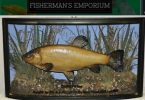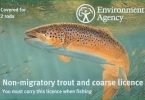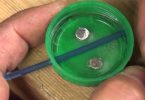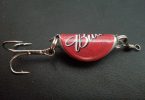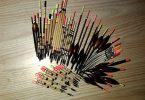Many American and Australian anglers are becoming interested in British and European methods of fishing. Hopefully this article will help explain the huge differences between the two styles. There’s no doubt that all of us, wherever we are, can learn a lot from reading about successful techniques in other parts of the world.
Fishing in the U.K. is divided into 3 categories:
Sea Fishing
This is the easy one – saltwater fishing.
Game Fishing
This has a totally different meaning on this side of the Atlantic and means fishing for members of the salmon family. Our four most common game fish species are the Atlantic salmon, brown trout, sea trout (simply brown trout that migrate to the sea and return to freshwater to spawn) and rainbow trout. The latter rarely breed in the U.K. and none are migratory so we have no steelhead – more-s the pity! Strictly speaking grayling are members of the salmon family but are not usually considered game fish as they spawn in the spring. Instead they count as coarse fish.
Coarse Fishing
Freshwater fishing for other than members of the salmon family. Species include what Americans class as game fish e.g. (northern) pike and (yellow) perch. Many of the others are members of the carp family, and it will surprise many American and Australian visitors to know that carp are by far the most popular quarry of coarse anglers!
Both sea fishing and game fishing in the U.K. are broadly similar to other countries. Perhaps the main difference is that the vast majority of trout waters allow only fly fishing.
However, coarse fishing is completely different to what many overseas anglers will be used to. So this article will concentrate on this style of fishing.
Catch and Release
In coarse angling catch and release is not just the norm, it is actually against the rules on most waters not to return the fish. In fact if you were to kill a coarse fish except for bait over here, you’d likely get lynched! This is nothing new as catch and release has been practised for over 100 years in the U.K.
The result is that the fish wise up to baits and methods and become very much harder to catch. This is especially so with carp which have particularly long memories. Because of this increased challenge and the fact that they are hard fighters, carp fishing is the most popular branch of angling in the U.K.
Boats
Because U.K. waters are usually much smaller that those in the States boat fishing is usually prohibited. Indeed, few Brits go boat fishing other than out to sea and to a much lesser extent for trout. The trout fishing is usually in upland lakes or in the relatively few water supply reservoirs we have. Usually only fly fishing is allowed and trolling is often prohibited, even where there’s space, as many consider it unsporting. However, trolling is practised by pike anglers.
The more enlightened trout fisheries also open their doors to pike fishing in the winter, although many insist that all pike are killed because they eat the trout. The result, as Americans could tell them, is an explosion of small pike that eat even more trout!
The boats used on U.K. lakes are what in America are called jon boats and are usually powered by oars or small outboards up to 6h.p. However sonar units are becoming popular as are trolling motors, which are often used as the main source of propulsion, especially where gasoline motors are prohibited.
Static Fishing
The vast majority of British coarse fishing is static. In other words the bait is not moved – even slowly. (The main exception is float fishing in a river). One way of comparing the two styles is to say that Americans hunt for their fish, Brits trap them.
This means that we have to attract the fish by something other than movement, and the normal way is to use groundbait (chum), which in some U.S. areas is actually illegal. This groundbait is often cereal based which has several advantages including being able to be used at long range, or may simply be the same as the hookbait, in which case it’s called loose feed.
For smaller species of fish the most popular bait is maggots, which are sold in more or less every coarse fishing shop. Fishing just 1 or 2 maggots on the hook demands fine tackle otherwise the bait won’t behave naturally, and so small hooks and light lines are often used, for instance a size 20 hook to 1lb. line.
Carp anglers will try and avoid smaller species of fish as hooking them will often scare the carp. Boilies are the bait of choice and these are paste baits boiled so that a hard skin is formed making them impossible to be pecked at by small fish and too big for them to crush and swallow.
Distance Fishing
Because there’s little boat fishing and because carp in particular learn to avoid bankside disturbance, a lot of U.K. anglers fish at ranges that would surprise their U.S. counterparts. Our casts aren’t measured in feet but in yards! For instance carp anglers commonly fish at distances in excess of 100 yards, occasionally 150 yards. Casting this far requires longer rods than are usually used in the States and the most popular length is 12 feet.
Match Fishing
Long rods are also used in matches (competitions) where the winner is the angler who catches the highest total weight of fish. Because there are many more small fish than big ones, match anglers usually aim to catch a large net of small fish. This requires a great deal of finesse and a long rod, typically 13 feet, is used to delicately control the tackle. For maximum tackle control at short range a graphite pole is used and these are often 36 feet or more in length! However, instead of a reel, a pole angler relies on stretchy elastic to control any bigger fish hooked.
Baits and Lures
Probably the main difference in methods between British and American angling is that we Brits spend most of our time fishing with bait rather than lures.
There are perhaps two main reason for this. Firstly we have relatively few predatory species, the main ones being pike and perch. Both of these grow to a higher average size than in the States, although the maximum weight for pike is similar on both sides of the Atlantic. It’s just that we have a higher proportion of 20 pounders – rather like Canada as opposed to the USA. On the other hand our perch grow much bigger, with our record standing at 5lbs. 9½oz. and with anything over 2½lbs. counting as a specimen ( = U.S. trophy). In some areas we also have zander, which are very similar to walleye.
In fact because most of our fish are non-predatory many anglers are brought up on bait fishing and have never even tried lures. If they did they may be hooked!
The second reason is once again catch and release. Fish that are returned wise up to lures much quicker than to baits. After all, the only lures they take have hooks on them! On the other hand bait is often part of their natural diet or becomes so with frequent groundbaiting (chumming).
It’s fair to say that most American and Australian anglers are as far behind us Brits in bait fishing as we are behind you in lure fishing. We therefore have a lot to learn from each other. However bear in mind that fish that have rarely been targeted with bait will often be caught very easily on British methods, at least until they wise up. Conversely you may be surprised to hear that many Brits find lure fishing relatively easy on waters that haven’t seen artificials at all! In other words it’s what the fish are used to that determine how easy or difficult they are to catch.
Confusing Terms
Many of the terms used by U.K. anglers will be confusing to their American counterparts. What’s worse is that some words have different meanings in each type of English! Below is a brief list of some of the most easily muddled.
| British | American |
| bank | shore |
| bite | strike |
| bivvy | tent |
| blanked | skunked |
| buzzer | electronic bite alarm |
| carbon or carbon fibre | graphite |
| drogue | sea anchor |
| float | bobber |
| gag | jaw spreader (banned on many U.K. waters) |
| game fish |
members of the salmon family (h |
| grinner knot | uni-knot |
| groundbait | chum |
| hooklength (or tail) | snell |
| half blood knot | clinch knot |
| lobworm | night crawler |
| rings | guides |
| rod rest | sand spike |
| run | strike from a big fish |
| running lead | slip sinker |
| slider or sliding float | slip bobber |
| specimen | trophy or lunker |
| stringer – Dissolving string that groundbait is threaded onto | stringer – String to which fish are attached to keep them alive and fresh after capture |
| to strike | to hook |
| tip ring | tip-top |
| trace | leader |
| tucked ½ blood knot | improved clinch knot |
| water knot | surgeon’s knot |
| weight | sinker |
© Steve Burke – Updated September, 2002

